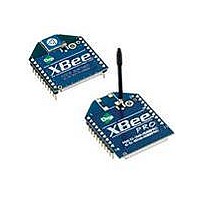XBP09-DPSIT-156 Digi International, XBP09-DPSIT-156 Datasheet - Page 15

XBP09-DPSIT-156
Manufacturer Part Number
XBP09-DPSIT-156
Description
MODULE XBEE PRO W/RPSMA
Manufacturer
Digi International
Series
XBEE-PRO™r
Specifications of XBP09-DPSIT-156
Frequency
902MHz ~ 928MHz
Data Rate - Maximum
156kbps
Modulation Or Protocol
FHSS
Applications
ISM
Power - Output
17dBm (50mW)
Sensitivity
-100dBm
Voltage - Supply
3 V ~ 3.6 V
Current - Receiving
80mA
Current - Transmitting
210mA
Data Interface
PCB, Through Hole
Antenna Connector
RP-SMA
Operating Temperature
-40°C ~ 85°C
Package / Case
Module
Lead Free Status / RoHS Status
Lead free / RoHS Compliant
Memory Size
-
Lead Free Status / Rohs Status
Lead free / RoHS Compliant
Other names
602-1169
XBee‐PRO® 900 RF Modules
Once the AT command mode sequence has been issued, the module sends an "OK\r" out the
DOUT pin. The "OK\r" characters can be delayed if the module has not finished transmitting
received serial data.
When command mode has been entered, the command mode timer is started (CT command), and
the module is able to receive AT commands on the DIN pin.
All of the parameter values in the sequence can be modified to reflect user preferences.
NOTE: Failure to enter AT Command Mode is most commonly due to baud rate mismatch. When using
XCTU, ensure that the ‘Baud’ setting on the “PC Settings” tab matches the interface data rate of the RF
module. By default, the BD parameter = 3 (9600 bps).
To Send AT Commands:
Send AT commands and parameters using the syntax shown below.
Syntax for sending AT Commands
To read a parameter value stored in the RF module’s register, omit the parameter field.
The preceding example would change the RF module Destination Address (Low) to “0x1F”. To
store the new value to non-volatile (long term) memory, subsequently send the WR (Write)
command.
For modified parameter values to persist in the module’s registry after a reset, changes must be
saved to non-volatile memory using the WR (Write) Command. Otherwise, parameters are
restored to previously saved values after the module is reset.
Command Response. When a command is sent to the module, the module will parse and
execute the command. Upon successful execution of a command, the module returns an “OK”
message. If execution of a command results in an error, the module returns an “ERROR” message.
Applying Command Changes
Any changes made to the configuration command registers through AT commands will not take
effect until the changes are applied. For example, sending the BD command to change the baud
rate will not change the actual baud rate until changes are applied. Changes can be applied in one
of the following ways:
To Exit AT Command Mode:
1.
2.
Timeout) Command, the RF module automatically returns to Idle Mode.
For an example of programming the RF module using AT Commands and descriptions of each config-
urable parameter, refer to the Command Reference Tables chapter.
© 2009 Digi International, Inc.
• Input three plus characters (“+++”) within one second [CC (Command Sequence Character)
• No characters sent for one second [GT (Guard Times) parameter = 0x3E8]
• The AC (Apply Changes) command is issued.
• AT command mode is exited.
parameter = 0x2B.]
Send the ATCN (Exit Command Mode) command (followed by a carriage return).
If no valid AT Commands are received within the time specified by CT (Command Mode
[OR]
15














